Ref: LB&SC Locos Pt.2: D1 Tanks
It’s been quite a while since I’ve posted to the Journal – a case of life getting very much in the way of model making, even of the armchair (I should be so lucky) variety. Fortunately Graham has kept you all rapt with his track making exploits, the results of which are stunning.
Something else stunning tumbled through the letterbox this morning; an exquisite set of etched number plates for No.299 New Cross. The model will be based on the Albion Models kit, so the plates are now safely stashed away with the etchings and castings for one fine day.

The plates are from Chris Watford’s Severnmill Models range, and there are quite a few LB&SC number plates in his catalogue, each priced £10. Other Brighton number plates not currently in the range cost £20 for the design and supply of one pair, and in the next few weeks Chris expects to be producing his last batch of etchings, so now is a very good time to stop procrastinating and order what you need (or might need if a modelling whim takes you!).
Basilica Fields is a 7mm model of a railway set within the context of the East End of London… a “what if” railway with a supporting history which is sometimes somewhat different to the expectations of academics and historians of all persuasions. Within the world of Basilica Fields there are several, separate, “scenes” which represent different railway locations in the vicinity of Bishopsgate – Artillery Lane is the first scene to be brought before the public gaze. The railway history of Basilica Fields is set in late Victorian / early Edwardian days and this brings a pleasing benefit in that the model shall present railway services from up to seven railway companies running on the tracks of just one or two, or maybe, three pre-grouping railways.
The permanent way for Basilica Fields is built to S7 standards – 7mm scale modelling with a track gauge of 33mm, (Scaleseven track and wheel standards). There is no “S7 equivalent” to buying a box of “O-gauge track” over the shop counter so all of the permanent way for Basilica Fields is hand-built. As the S7 standards for track are generally independent of company…. and track has to be constructed to represent the permanent way of at least three pre-grouping companies (Metropolitan Railway, Great Western Railway and Great Eastern Railway)…. then this post describes the construction of plain track in a generic way. Where the 7mm track has a feature which is company-specific then that feature is covered within the descriptions of the prototype permanent way; so for example:- the use of a jig to provide sleeper spacing is described here whilst the details of the sleeper spacing are to be found in the respective descriptions of Permanent Way.
So where to start? Perversely, with the end product so as to explain the philosophy behind preparation of parts.
I have been making S7 track for at least five years and what follows represents my approach to achieving a consistent result and where the initial colouring of the components has been achieved before assembly. The appearance of the track panels at this stage is “clean”…. colouring of components before and weathering after assembly is easier than assembly/laying/painting in place. All of the weathering is to be done after the track has been laid and the techniques are to be covered in a separate post.
The sleepers are made from Lime and are of scale 9′ x 10″ x 5” dimensions. The sleepers for Basilica Fields are supplied ready-cut from Perfect Miniatures. The colouring process uses shoe dyes with IPA to let down the intensity of the dye and as a medium when the sleepers are immersed in the dye. Much of the track of Basilica Fields is set in brick-lined cuttings where the sun shines on the track for just a few hours of the day, so the initial staining of the sleepers represents timber which has retained something of its original colour and yet appears to be damp and dirty. The initial stain is a 10% by volume solution of the brown dye…. with several “dips” to build up the colour. After the sleepers have attained a deep brown colour the damp and dirty colouration is applied by immersion in a solution of 10% brown and 10% black by volume.
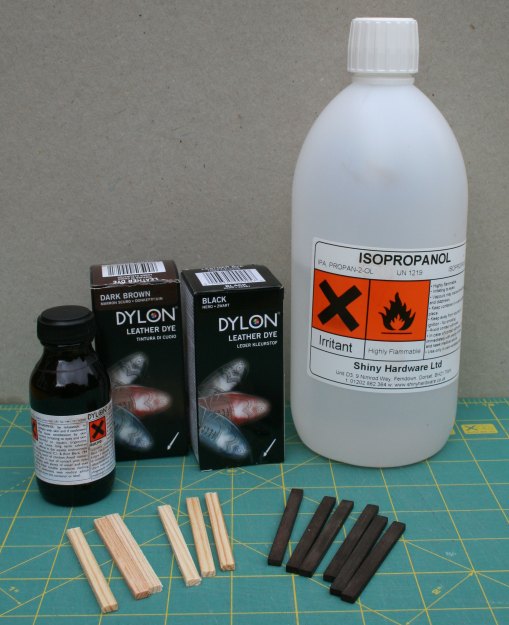
In the beginning - dyeing materials
The stain solution is made up in a plastic tub, the sleepers dropped in and the tub agitated (gently!) to ensure that the sleepers are covered and wetted all over. After five minutes in the solution the sleepers are drained using a metal kitchen sieve (retained for the sole use in staining) and then left to dry on newspaper… with the drying sleepers being “tumbled” occasionally to promote the drying process and to avoid a blotchy appearance.
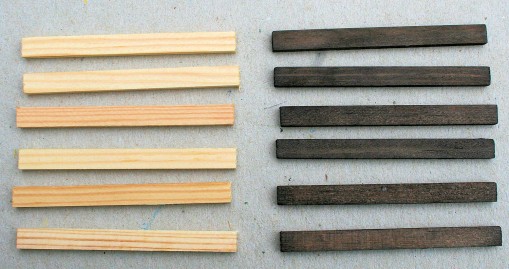
Sleepers - before and after
Now on to the chairs… in this case the chairs are from the C&L Finescale range as being similar to those used by the GWR circa 1895, (see the drawing in GWR PW for Gun Street). Enamel paints (Humbrol) are used for painting the chairs with the “dirt and weathered rust” colour from a palette of black, brown and gunmetal (33, 133 and 53 respectively). The oak keys are then painted using a mix of “track dirt” and “rusty rails” (Precision Paints). Keen-eyed readers will spot that the chair sprue has chairs with keys to the left and chairs with the keys to the right…. this difference between “LH” and “RH” chairs is important when fitting chairs to the rail.
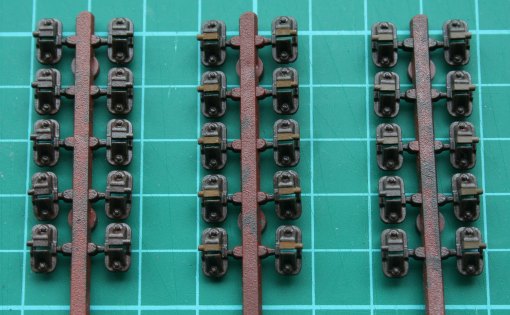
Painted chairs - rusty (left) and dirty keys (centre and right)
Sleepers are loaded into a jig which enables sleeper spacing along the rail to be replicated for each new panel; in this case all of the sleepers are the same width (GWR – 10″), where a track panel has wider sleepers at the ends then that increased width is accomodated within the appropriate jig (Met. Rly. – 12″). Chairs are slid onto the rail, which is blackened chemically, with care taken to ensure that the keys are aligned correctly for the intended use of the track panel (and with the keys of the outermost chairs arranged so as to be “driven” towards the fishplates). The rails are held at 33mm apart by S7 Group track gauges – available from the S7 Group stores and a benefit of group membership.
The chairs are fixed to the sleepers by Butanone which is applied by brush on eitherside of a chair where the chair touches the sleeper. The chairs are moulded in ABS and that plastic is soluble in Butanone. The solvent runs into the gap between the chair and sleeper, dissolves the base of the chair and the resulting ABS “gloop” gets drawn into the grain of the sleeper (by virtue of the solvent which has been absorbed by the timber).
The jig is a piece of 3/4″ chipboard upon which is fixed a distance piece cut from 4mm MDF – the MDF is 55mm wide and less than the length of the sleepers (63mm). Thin, 1/16″, ply spacers are glued on top of the distance piece – the width of the spacers is such as to place the sleepers at the required centres. The sleepers extend beyond the distance piece so that an assembled track panel can be removed by raising all sleepers at the same time rather than sliding the panel sideways (if a sleeper sticks as a panel is slid sideways then that “sticky” sleeper can impart a twisting moment to the bond between chairs and sleepers).

track jig with sleepers and rail/chairs/gauges
“Here is one I prepared earlier”… a representation of a GWR track panel with 32′ rails, 13 sleepers and appropriate chairs and fishplates (as in the GW PW post referenced earlier).
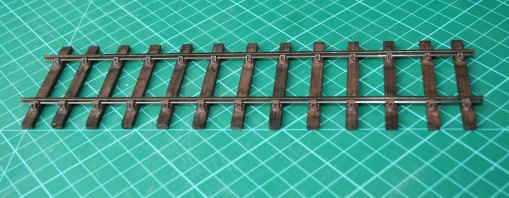
The final result - a representation of GWR track panel, 32'0" rails, 13 sleepers, circa 1895
One of the benefits of 7mm scale modelling is that parts are bigger and more detail can be included. Exactoscale locking fishplates are fitted to the track here, these fishplates are moulded in ABS and hence provide insulation between rails. Each moulding has bolt heads on one side, and nuts on the other side, of the moulding. The light colour of the keys allows the placing of the keys to be seen with the outermost chair placed so that the key is “driven” towards the fishplate.
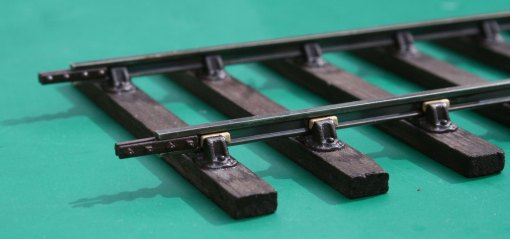
Completed track - fishplates and keys
Graham
Ref:- Quirky Query 2 – GWR PW in Victorian times
We left Quirky Query 2 with some photos of a GWR rail chair (in my care) and the question… “is the chair an example of the type for the 86lbs rail of 1882 ?”. None of the comments on that post have provided a definitive answer… rather those comments have deepened the puzzle. In the meantime, Adrian and I had concluded that the sidings in Gun Street depot were subject to frequent renewal and so the model shall portray the GW PW of the mid 1890s rather than of the early 1880s. However, the comments to Quirky Query 2, combined with new photographs, suggested that there is more to the original post than was thought. In taking this story forward, I am glad to acknowledge that the comments on QQ-2 awakened a recollection as to where I might find some contemporary material. A recent bright and sunny day provided the ideal opportunity to do some detective work and the results are presented here.
Our railway “heritage” sites provide railway historians with many opportunities to study artefacts from an earlier age and none more so than with bits and pieces from the railway infrastructure – in this case the simple rail chair. At one particular heritage site an unknown person has “collected” examples of chairs from a range of pre-group companies…. and that collection includes a couple of chairs which are very similar to my example. The photographs below show an example of the type with raised rather than recessed lettering – just as predicted in a comment to QQ2.
The first photograph shows a side view of the chair – with the word “patent” visible in raised letters.
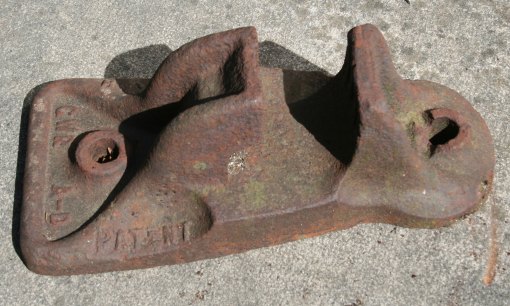
GWR Chair - 1
The second photograph shows an end view – with “GWR” and “A-D” in raised letters. I hope that a reader can explain the significance of “A-D”. In passing, note the grooves to the inner face of the far jaw… a feature which is discussed later in this post.

GWR Chair - 2
The third photograph is another side view – and shows yet more raised lettering,”Mc K & H” which I feel is likely to be McKenzie & Holland (a signalling contractor).
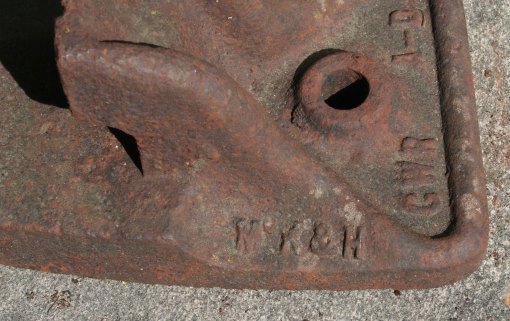
GWR Chair - 3
The Malvern Industrial Archeology Circle website offers an outline of the history of Mckenzie & Holland where the origins of the signalling manufacturer is recorded as “Thomas Clunes”, iron and brass founder of the “Vulcan Iron Works” in Worcester. McKenzie & Holland as a company name dates from the mid-1870s which means that the chair in the photograph is post circa-1875. What aspect of the chair is the subject of the “patent” is not yet known to me.
Returning to the chair in the original QQ2 post, the similarities between that chair and the casting above are very strong, the only significant differences are the lettering and the manner in which the lettering is represented – comments to QQ2 noted that raised letters are easier than recessed letters for cast items… and that the “pattern” for the chair casting was likely to have been made as a metal item (from a wooden master with double shrinkage allowances). In the absence of any information about the nature of either the “patent” or the business relationship for supply of castings – the possibility exists that the GWR bought the patent-rights from McK & H and thereby gained a metal pattern for the cast-iron chair. Removal of the raised lettering on the metal pattern would be fairly easy – building up new lettering would be difficult and hence one can suggest that the new lettering was “engraved” into the metal pattern hence the recessed lettering on my chair.
As for the vertical grooves in the jaw, Harvie (1898) records that the GWR had been experimenting with spring clips as an alternative to oak or teak keys. The relevant text refers to a circular spring clip being inserted into the space between the jar and the rail with the ends of the clip bearing on the rail. Whilst not conclusive the grooves on the face of the jaw may be related to the use of such clips.
Unfortunately none of the above furthers the case for the original question… however, the similarity of my chair to the McK & H specimen puts the likely date of casting as contemporary with the introduction of the 86lbs rail in 1882.
Graham
When Adrian and I first discussed the idea for Quirky Queries we realised that we might have found a way of tidying up some loose ends from main-stream posts and of providing a means where railway historians could fill in the details. There have been favourable responses to the initial Quirky Queries and one of those responses has caused a rethink on the “Quirky Category”. Our expectation was that the questions posed might lead to discussion and the occasional snippet of information, all of which could be achieved by way of the “comment / reply” facility of the journal – what had not been expected was that a “Quirky Query” might take on a life of its own…. or that there might be further photographs relevant to specific subject.
Such has happened… the query about early GWR chairs has raised other questions on that subject and some interesting photos have become available to the journal. So rather than disturb the slumber of Quirky Queries the journal now features a new category…. Quirky Answers.
Quirky Queries and your comments on those posts relate to the world of Basilica Fields, the railway services and the environment in which run those services. Quirky Answers records questions and answers which, whilst not necessarily an integral part of the Basilica World story, are of sufficient interest as to warrant bringing to a wider audience.
As always, your contributions are encouraged.
Graham Beare









